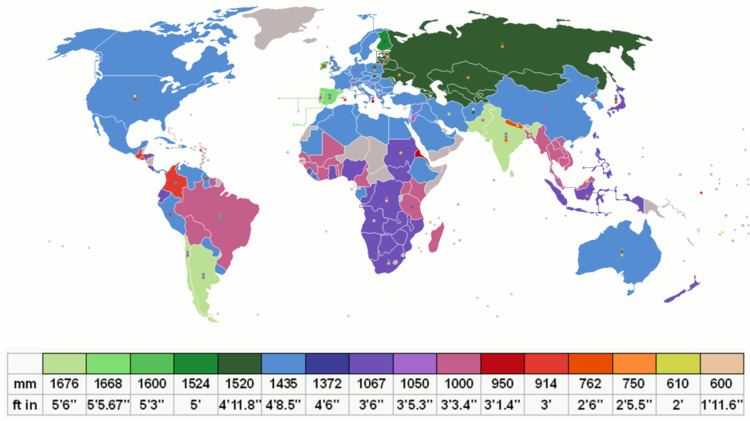 | ||
5 ft 6 in/1,676 mm gauge is a broad track gauge commonly used in India, Pakistan, Sri Lanka, Argentina and Chile, but is also used on BART (Bay Area Rapid Transit), in the San Francisco Bay Area, United States. It is historically known as "Broad gauge" on the Indian subcontinent or "Provincial gauge", "Portland gauge" or "Texas gauge" in North America. It is the widest gauge in regular use anywhere in the world.
Contents
Scotland
See 5 ft 6 in gauge in ScotlandThis gauge was first used in Scotland for two short, isolated lines, the Dundee and Arbroath Railway (1836-1847) and the Arbroath and Forfar Railway (1838- ).
India
In India, the Governor-General James Andrew Broun-Ramsay, 10th Earl of Dalhousie determined that a wider gauge than 1,435 mm (4 ft 8 1⁄2 in) standard gauge was more suitable for larger firebox and stability in high winds and long steep gradients.
"The first agreement of the Government of India with East Indian Railway Company and Great Indian Peninsula Company in 1849 stipulated that railways in India would be built on a four feet, eight and half inches gauge. However, soon there were disagreements with Lord Dalhousie favoring a 6 ft (1,829 mm) gauge and Mr. Simms, the consulting engineer favoring five feet and six inches gauge. The debate was finally settled in favor of the five and half feet gauge, called the broad gauge in 1850s and the first train that ran from Bombay to Thane ran on broad gauge."
In the late 20th century, India adopted Project Unigauge. Gauge conversion towards Indian gauge is underway, replacing several narrow gauges and metre gauges.
To achieve long term economic feasibility of railway projects by transporting more cargo and passengers, all of India's new railway lines will be built with Broad-gauge, with the Dedicated Freight Corridor also built using Broad-gauge.
Pakistan
Pakistan uses primarily broad gauge, but also has a mix of metre gauge and other narrow gauges.
Bangladesh
The Bangladesh Railways uses a mix of broad gauge and metre gauge. The broad gauge network is primarily located to the west of the Jamuna River, while the metre gauge network is primarily located to its east. The Jamuna Bridge is a mixed use bridge that contains a dual gauge connection across the river linking both networks.
Sri Lanka
Sri Lanka previously had a mix of broad gauge and other narrow gauges. However, all services currently operate on broad gauge as the other lines have either been closed or converted.
Canada
In the 1850s it was first used in Canada, and was then used in other British colonies. It was known as the "Provincial gauge" in Canada. The earliest railways in Canada, including the 1836 Champlain and St. Lawrence, 1839 Albion Colliery tramway and 1847 Montreal and Lachine Railway were all built to standard gauge.
The Grand Trunk Railway which operated in several Canadian provinces (Quebec and Ontario) and American states (Connecticut, Maine, Massachusetts, New Hampshire, and Vermont) used it, but changed to standard gauge by 1873. The Grand Trunk Railway was operated from headquarters in Montreal, Quebec; but corporate headquarters were in London, England. The St. Lawrence and Atlantic Railroad which operated in Quebec, Vermont, New Hampshire and Maine also used it and was converted in 1873.
There is a longstanding rumour that the Provincial gauge was selected specifically to create a break-of-gauge with US railways, the War of 1812 still being a fresh memory. However, there is little supporting evidence for this, and this story appears to be traced to a single claim from the late 1800s.
United States
The Bay Area Rapid Transit system is the only operating railroad in the United State to use Indian gauge, with 104 miles (167 km) of mainlines. The original engineers for the system had background in aerospace (rather than railroads) and intended to make a state-of-the-art system for other municipalities to emulate. The use of Indian gauge rails was one of many unconventional design elements included in its design. In addition to its unusual gauge, it also uses flat-edge rail, rather than typical rail that angles slightly inward. This has complicated maintenance of the system, as it requires custom wheelsets, brake systems, and track maintenance vehicles.
The New Orleans, Opelousas and Great Western Railroad (NOO&GW) used Indian gauge until 1872, and the Texas and New Orleans Railroad used Indian gauge ("Texas gauge") until 1876. The Grand Trunk Railway predecessor St. Lawrence and Atlantic Railroad which operated in Quebec, Vermont, New Hampshire and Maine also used Indian gauge ("Canadian gauge" or "Portland gauge") and was converted in 1873. Several Maine railroads connected to the Grand Trunk Railway shared its "Portland Gauge". The Androscoggin and Kennebec Railroad and the Buckfield Branch Railroad were later consolidated as the Maine Central Railroad which converted to standard gauge in 1871. The only electric streetcar system in the U.S. to use this gauge was that of Fairfield, Maine.
John A. Poor's chief engineer Alvin C. Morton compiled the following advantages of "Portland Gauge" for Maine railways in 1847:
Similar gauges
Iberian gauge (1,668 mm or 5 ft 5 21⁄32 in) is closely similar, with only 8 mm (5⁄16 in) difference, and allow compatibility with the rolling stock. For example, in recent years Chile and Argentina had bought second hand Spanish/Portuguese Iberian-gauge rolling stock.
